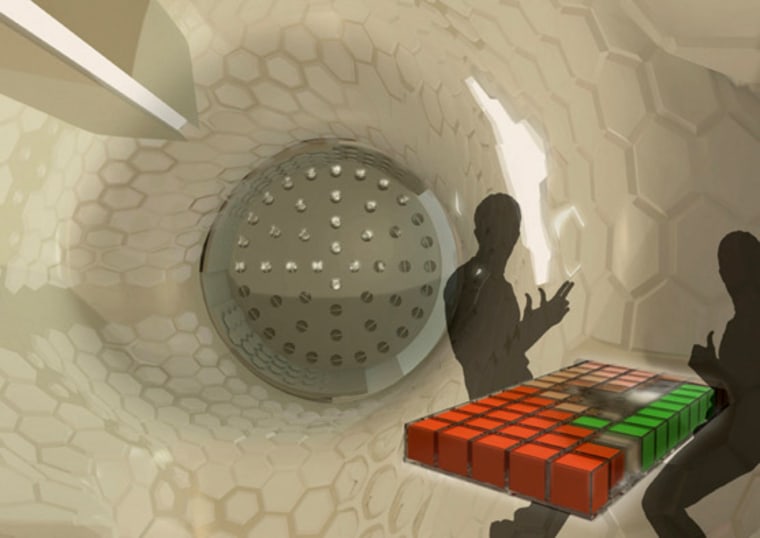Space tourism may face some challenges with the uncertainty over the next-generation rides into space. But that hasn't stopped Earth designers from envisioning future space hotels for paying thrill seekers.
A robot concierge, a redesigned showerhead and a full-sensory exercise wall are just part of the Space Hotel Project created by master's degree students in a program hosted by Imperial College London and the Royal College of Art in the U.K. The concept could theoretically attach to the international space station, so long as the growing space outpost remains in orbit.
"From personal hygiene to sleeping in zero gravity, we encouraged the students to be completely creative with their solutions so that the living conditions in the world's most isolated hotel could be as comfortable as possible," said Daniele Bedini, a space architecture expert who has worked for NASA and the European Space Agency on moon and Mars base designs.
The new space hotel concept includes a rigid module similar to Europe's Columbus laboratory on the space station, as well as an inflatable sphere developed by Thales Alenia Space in Italy.
Bedini told SPACE.com that the space hotel could be built tomorrow with today's existing structures and technologies. He compared the process to luxury airlines buying an airplane structure and personalizing the interior.
Keeping clean in microgravity
Space hygiene has always proved a challenge, but space hotel designers tackled everything from smaller vacuum-powered toilets to new clothing to keep odors down.
"There are no washing machines or tumble dryers in space so we had to design clothes that enabled the skin to breathe, which reduces sweating, smells and the need for clothes to be washed," said Katrin Baumgarten, a student in the Innovation Design Engineering program at Imperial College London. "We achieved this by using natural fibers that breathe and we also made small chest flaps, which let the air in to keep the body cool and comfortable."
A redesigned showerhead could also help tackle the washing problem in space by using many small holes to squirt small amounts of water and soap, and another set of holes to suck up water for recycling. Water only comes out of the holes in contact with the skin, and so avoids leaving liquid globules floating around.
Cleaning up after stray food crumbs or globules may similarly become a cinch. An "AirMaid" cycle would operate during the night period on the space hotel to suck any offending particles out of the air, just like the space station's air conditioning unit operates.
A personal touch in space
Staying fit and healthy on a space vacation need not resemble a grim daily ritual. Student designers suggested an exercise wall and a routine where space tourists would pull on elastic bands in time with lights and music. But astronauts may still prefer running on the COLBERT treadmill named for comedian Stephen Colbert.
Food would also become a snap with customizable menu, and a robotic arm that connects food containers in rows to create a tray-table.
The redesigned space hotel experience extends to the waking and sleeping patterns, which face the challenge of dealing with 16 sunrises and sunsets within the span of typical Earth day as the station orbits the planet every 90 minutes.
Astronauts on the space station today typically adhere to a daily schedule anchored to Greenwich Mean Time, which dictates when their work days begin and end.
Space hotel designers decided to incorporate light-emitting diodes (LEDs) into the walls and storage spaces, and leave the natural light coming from outside. The exterior glass would only darken to reduce the level of incoming light during Earth's night cycle, and help space tourists adjust to the new patterns of night and day.
A stand-alone lamp powered by glowing algae might also accompany space tourists wherever they go, the student designers proposed. That could serve as a poignant reminder of the life swarming across the planet below.
Getting off the ground
Any space hotel or tourism concepts must overcome a stiff challenge from a budget crunch.
Space tourists going up to the space station face a squeeze for seats on the Russian Soyuz spacecraft, if NASA follows an original plan to end space shuttle flights by 2010. That would require the U.S. space agency's astronauts to take Russian rides into orbit until NASA's Constellation program finds its legs.
The shortfall in manned spacecraft capability has space tourist outfits seriously worried, given that their paying passengers may lack the rides to get where they're going. One company, Bigelow Aerospace of Las Vegas, Nev., a proponent of inflatable space station modules and future space hotels, has proposed how to rescue the Constellation program and its Orion spacecraft with an Orion-Lite concept that pares down NASA's original design.
Still, uncertainty has not stopped Bedini and his students from working on ways to inject fresh food into their tray-table concept. Bedini also wants to test of a floating camera on the space station, which could eventually lead to a robot concierge snapping vacation photos for space tourists.
Some of the ideas could become reality under Bedini's contract with Thales Alenia Space. Bedini even hopes to pitch the space hotel concept to private companies and space agencies, and perhaps make the space station an even livelier place in the future.
Designers who want a taste of extreme interior decorating can sign up for Bedini's course in Space Design at the Royal College of Art in London next year.
